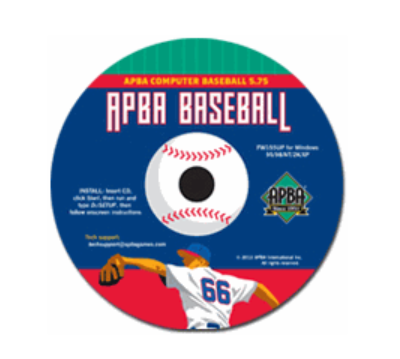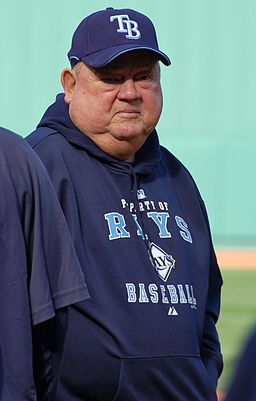Chris Williams contacted me a few weeks back asking if he could post some information on The APBA Blog. He has composed and collected helpful info mostly related to APBA Baseball for Windows (BBW). Some are in-depth articles and others are tips and techniques which may come in handy.
This is the first installment on Chris on APBA.

Every manager is comprised of four files (.lib, .mob, .msy and .dct). You must copy or move each of these four files into your BBW directory or folder.
The managers files can only be 8 letters long including the Mgr prefix. You can change the name to anything as long as the letters Mgr are included.
Managers don’t create or make lineups. That’s done by the auto-lineup generator in League Manager. If a guy is being overly used in a rarely played position, that’s LM’s doing.
The term low power hitters refers to players with .080 or below isolated slugging. In other words, singles hitters.
With most replay Advanced Injury Management managers the recommended settings are:
- AIM
- Game Injuries and Fatigue
- Enforced Batters Faced
- Appropriate Recovery Rate
You do not have to have all of the above settings on. However, you must have AIM on.
An excellent idea for greater variety in a replay is to use a mix of micromanagers. For the 1940’s you can use Lopez I post-1945 for clubs that had higher Complete Game totals and lower bullpen usage than the average for the league or season. Additionally, Lopez I is better suited to handle very poor teams with high team ERA and a more plodding base running style (e.g., station-to-station advancement and low number of Stolen Bases).
Teams that had either aggressive base stealing and more liberal use of the H&R would be better handled with Lopez II. Pre-1945 staffs meanwhile that had higher than average ratio of Complete Games to relief appearances would also be better managed with Lopez II. You can also use the 1930’s manager Wilson for teams that were more conservative during the era. Also, use Muddy Harris I for teams that had a lower number of Complete Games with more liberal player substitution and usage.
A smart approach in a selecting manager for your draft roster is to first run a series of “spring training” or test games with the programs. Since there are so many managers to select from it’s hard to determine which one is best with your roster. Try to use your regular season best roster of 25/26 players and not the full set of players that you have. Playing test games with 35+ players won’t give you a good idea of how the manager will handle situations where your bench or bullpen is thin due to fatigue or injuries.
A test run of 40 games or so should give you a good idea as to how the manager will handle your roster. Most important: run the games through League Manager and not through Baseball. If you use the latter to test things out, you’ll get odd results.
Q. What is the downside of using a non-AIM manager in a draft league using AIM fatigue, no injuries and batters faced limits enforced?
A. Depending on the manager, they’ll tend to use tired or worn out players and pitchers who won’t perform as well due to their less-than-rested or ready fatigue status. Plus, since they ignore fatigue, they’ll likely overuse top players or pitchers and burn up their BFs or PR/RUse more quickly.

Also related (and in contradiction since it depends on the manager) they may not always use the best rested relievers in a critical situation. Since some are programmed to allocate or spread out bullpen usage (to prevent over and under- utilization), they’re likely to pass over a fully rested top reliever for a less than rested less reliever.
Think Don Zimmer, 1978.
Q. Why will runners with low steal ratings try to take a base late in games where their team is many runs ahead?
A. The general thinking with most of the other replay managers is that guys with a handful of attempts either got them on busted H&R plays or, more likely, when teams were asleep. My guess is that teams behind by a good margin (3 or 4 runs late) were more likely to pay less attention to these types. And that’s when they got their steals. Therefore, busted hit and runs or sleeping defenses were probably the situations.
To fix this, you can simply zero out the steal attempts for players using Wizards or the Player Editor and those guys won’t steal. Managers check steal attempts (in part) when deciding when or whether to steal. If they’re zero, the guys won’t (or shouldn’t) steal. This will also lead to canceling out the hit and run since guys on first have to have some attempts in order to activate the strategy.
A point to remember is that managers can’t read the steal allowance letter. For some reason the program can’t access that. That was an oversight. What the managers do is devise their own “letters” and use them instead. Basically, it’s steal attempts divided by times on first. That leads to a percentage and then the percentages are broken down into categories and given letters.
The Micro-Managers know everything. When they make a decision, it is based solely on the numbers. If you have programmed the runner to attempt to advance on a certain number, say 24 chances out of 36, then if the number is met (or is greater) then he will go. If not, he won’t. The Micro-Manager doesn’t pay any attention to Ernie’s call of the game at all. He is only concerned with the numbers. In that respect, the Micro-Manager is much better than a human player.
Thanks, Chris! Be looking for more helpful articles by Chris on a regular basis!!
Photo by Aaron Frutman [CC BY]



Do you know if the program for cloning Managers is still available somewhere online?